Arrival in Luang Prabang. Transfer to the hotel.
Rest of the day free time for leisure and exploring Luang Prabang on your own.



We pick you up at the hotel to start our city tour visiting the Museum in the former Royal Palace where you get a sense of local history. The palace was built in 1904 during the French colonial era.
We continue our tour to the most important monasteries of Luang Prabang, starting with Vat Xieng Thong, the most magnificent temple, built by King Setthathirat in 1560.
Next stop is Vat Saen and last but not least we enter Vat Vixoun, the oldest operating tour in Luang Prabang, built 1513.
After lunch, transport is provided to the nearby traditional Tai Lue weaving village Ban Phanom. This village is famed for its intricately woven textiles and special weaving techniques – in former times, it was the weaver colony of the Luang Prabang Royalty.
The very scenic Tad Sae Waterfall can be reached on the Nam Khan from Ban Phanom by long-tail boat – best during and after the rainy season. Its numerous cascades and pools are an ideal place for bathing.
On the way to the Tad Sae Waterfall lies the tomb of the 19th century French explorer Henri Mouhot, the first European to rediscover Angkor Wat and to visit the Royal Kingdom of Luang Prabang.



Early in the morning you have the opportunity to participate in the morning alm’s giving ceremony for the monks.
After breakfast we take a boat to visit the Pak Ou caves. The Pak Ou caves remain a popular pilgrimage site for local people. During Lao New Year in April, the caves are crowded with devotees who gain merit by ceremonially washing the Buddha statues. We will see two Hang-Lin used for this ceremony. The upper and lower caves are explored, before we are continuing at the village of Ban Xang Hai.
This village has for centuries made the earthen jars used as fermenting containers for Lao wine. Nowadays, it specializes in producing a wide range of lau lao (Lao whisky) and lau hai (Lao wine). Be sure to try just a little!
After return to Luang Prabang and lunch we make our way to the Kuangsi Waterfalls. The afternoon is spent bathing and relaxing by the turquoise pools below. See the bear sanctuary just by the entrance gate. Then we return to LP.



After breakfast transfer from Luang Prabang to Phonsavanh ( around 7-8 hours drive by private minivan).
Lunch is served in a local restaurant on the way. We arrive in Phonsavan in the late afternoon and drive straight to visit the Plain of jars Site No. 1 just 6 km away from Phonsavan town to enjoy the sunset above the hundreds of jars. The mysterious archaeological site is also discovered by UNESCO and there are plans to establish it as a World Heritage site.



Breakfast at hotel, and visit of the Plain of jars site No. 2.
We then continue to Mouang Khoune, the former capital city of Xieng Khouang province which was nearly completely destroyed by American bombers during the so-called Secret War. Many stops visiting minority villages of hill tribes can be done.
We stop for lunch at a local restaurant on the way to/from Mouang Khoune. Return to Phonsavan in the afternoon, if time allows we visit the Plain of Jars site No.3.

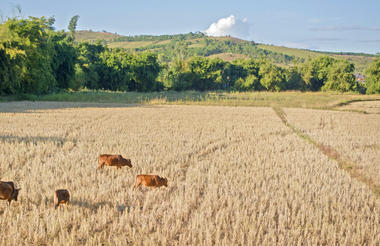
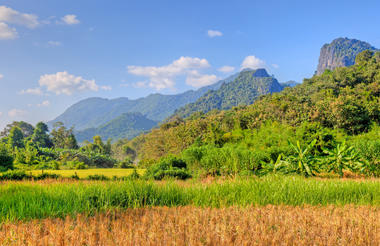
After breakfast transfer from Phonsavan to Vang Vieng ( 6 ½ hours). Lunch is served on the way.
Rest of the day free time for exploring Vang Vieng on your own.



Pick up from your hotel and after 14 km transfer to the north of Vang Vieng, we visit the first cave, Tham Xang (Elephant Cave) lies on the opposite banks of the Nam Song. It is an important Buddhist temple and owes its name to a remarkable limestone formation.
The nearby Tham Hoi cave (Snail cave) winds its way deep into the mountain. One hour of exploration through numerous corridors ends at a crystal clear spring. Here, swimming in the stream – in a cave lit up by candles – is possible all the year round.
The most beautiful cave on this trip is Tham Loup (Deep cave), our next stop for cave exploration. This cave is known for its many stalagmites and stalactites.
Another cool pool of spring water lies at the mouth of Tham Nam (Water cave), also a good place for a swim. Tubing inside the cave is possible.
After a picnic lunch, the trek to the Hmong village of Phathao passes through rice paddy fields and vegetable gardens.
The trip back to Vang Vieng varies according to the level of the Nam Song. Descending the Nam Song by kayak leads us through idyllic scenes of rural life: a unique sight with the Limestone Mountains in the background.
Approximately: 25 minutes transfer/ 1½ hour trekking/ 2 hours kayaking/ 2 hours caving.



Transfer to Vientiane by private Minivan (3 ½ hours). Check in at hotel and lunch.
Rest of the day free time for exploring Vientiane on your own. Take a stroll along the Mekong and visit the night market in the evening.



In the morning time, we take a sightseeing tour of Vientiane, to visit the religious museums of Wat Sisaket, the oldest temple, survived from the Siamese war of 1828. Its cloister contains more than 8000 Buddha statues; we continue to Ho Prakeo, the former home-temple of the Emerald Buddha statue or Pra Keo, from the early time of Lane Xang Kingdom until 18th century, but today it contains a collection of Buddha statues, antiques and artifacts found around Vientiane; the That Luang Stupa, the single most important monument in Laos, which was built to cover the original small stupa containing a piece of the chest bone of Buddha, That Luang serves as the main and symbolic stupa in Laos. It’s also our national symbol and recognizable throughout the world, gathering place for national Buddhism ceremony. It’s also the biggest stupa in Laos; Patouxay (Arch de Triumph), built quite recently in commemoration of those who died during the wars in the past and it is today the land-mark of Vientiane. We make a lunch stop at the famous Khop Chai Deu Restaurant.
In the afternoon, we continue the sightseeing tour to Carol Cassidy, a Gallery weaving Lao textiles and natural dye making process from A-Z; Buddha Park on the Mekong of which Buddha statues in modern style shapes. One of them is the largest Reclining Buddha in Laos. They were built by a Lao man in order to teach following generations about religions worldwide after his study in India.
We return to Vientiane in the late afternoon.



After an early breakfast we leave Vientiane southwards to visit the famous Konglor Cave (around 4 hours).
A private minivan brings us into our secret garden: the famous limestone forest of Phou Hinboun and the cave that own the flow of the river Hinboun. After a brief meeting with local guides and a short introduction of security issues, we provide you with torch and equipment and enter into the mouth of the cave, jump into our boat with a local boatman and cruise up the river Hinboun that flows through the cave.
This 7,5km underground cruise is really a unique experience and you will be amazed by this circuit passing from huge chambers to middle sized caves till getting out of the cave besides Ban Nathan village. Return by the same way.
After the tour through the cave we make our way back to the hotel.
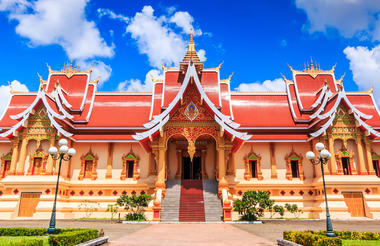
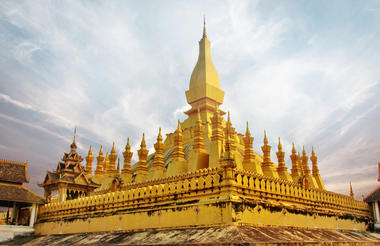
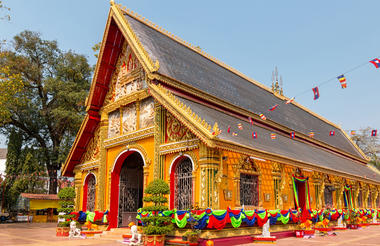
After a delicious breakfast transfer from your hotel to Pakse (around 6 hours).
On the way we will stop for lunch in a local restaurant and at That Hing Hang, just besides Savannakhet, the second most holy place in the country.
We arrive in Pakse and check in at the hotel. Rest of the day free for exploring Pakse on your own.



We depart at 8:30 am from your hotel.
We start out by driving out on the Bolaven Plateau, passing numerous tea and coffee plantations. The Plateau is the homeland to several Mon-Khmer ethnic groups and was part of the Ho-Chi-Minh Trail during the Second Indochina War.
We then go to see the breathtaking Tad Fane and Tad Ngoung waterfalls, the latter of which is a good spot for swimming and to have lunch.
We visit the local market at Paksong and Jhai’s Coffee fair-trade farmers co-op on the Plateau and make our way back to Tad Phaseum waterfall to visit some ethnic minorities (Laven,Ta oy, Aluk, etc) before continuing to Champassak. Approximately: Transfer 4-5 hours / hiking 2½-3 hours.



Early in the morning we visit the Khmer temple ruins of the world heritage site, Wat Phou. Return to the hotel for breakfast.
Next we drive to Ban Kiet Ngong for an elephant trek to the mysterious area of Xe Pian National Protected Area (NPA) to view wildlife and nature. Lunch at Kingfisher Eco-lodge.
After lunch we continue south to Don Khong Island to watch the locals make sugar from (Ton Tan) sugar tree using the fruits. Then we head south to Ban Nakasang and take a long-tail boat to Don Khone.
Enjoy the sunset along the Mekong with local fishermen. Approximately: Transfer 3½ hours/Elephant riding 2 hours, hiking 2 hours, boat 1½ hours.



Today is quite a relaxed day. We cycle to the old French wharf and along the old French railway line to Liphi falls. Return for lunch at Seng Aloun Riverside Restaurant.
Late in the afternoon we continue cycle to Don Det. Stop for a cool drink and optional tubing the Mekong back to Don Khone. Approximately: Cycling 4-5 hours / hiking 1 hour.


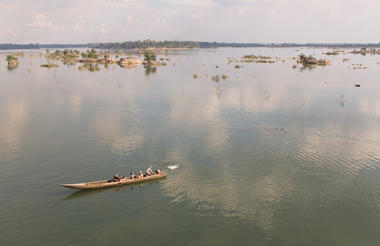
After breakfast take a boat downstream for about 25 Minutes to see the freshwater Irrawaddy Dolphin.
After spending a relaxing hour, watching and photographing the dolphins we undertake the 40 minutes to the Lao-Cambodian border by car to visit the biggest water fall in South East Asia (Khone Phapheng waterfall).
We have lunch at the falls before we make our way back to Pakse where we arrive in the afternoon.

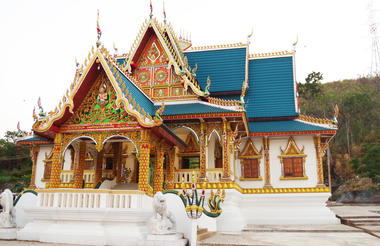
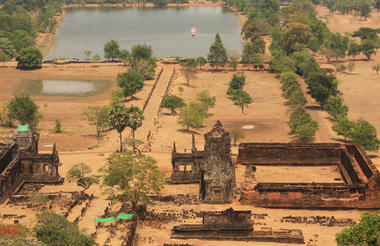
After breakfast transfer to the airport or bus station to reach your next destination.






